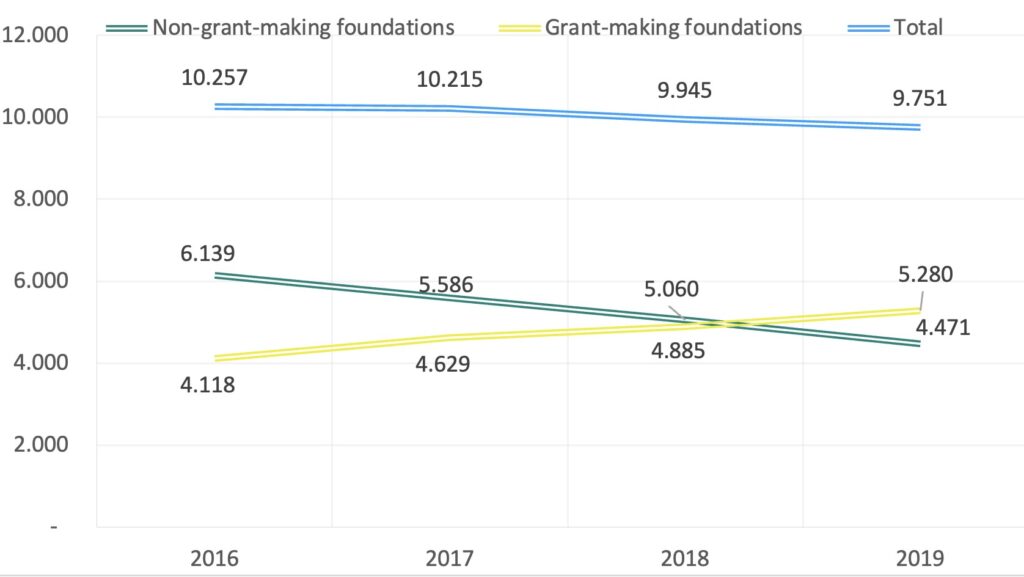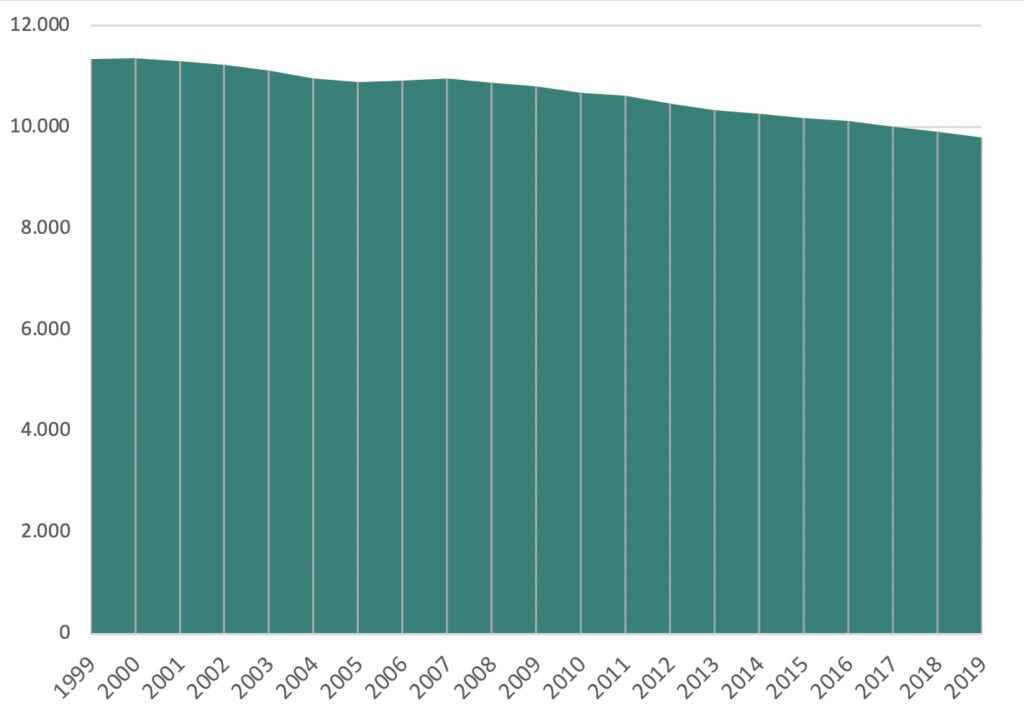Declining numbers, increased giving and what is behind it: Trends in the Danish foundation sector
By Christian Edelvold Berg, Senior Analyst at the Danish Knowledge Centre for Foundations
Developments in the Danish foundation sector in recent years show a surprising trend. On the one hand, there is an increase in giving from foundations and an increase in the number of foundations that grant money. On the other hand, the number of foundations overall is declining.
We asked two initial research questions concerning the declining number of foundations:
- What is the long-term development in the number of foundations?
- Why are small foundations important?
Increased grants from Danish foundations
The private Danish foundations donated EUR 2.64 billion in 2019 – an increase of EUR 402 million since 2016. This is by far the highest recorded amount from Danish foundations in the four years we have kept official statistics on foundation grants. In particular, Danish enterprise foundations have increased their grants, representing EUR 363 million or 90 % of the increase. Even though there is an increase in amount, there is also a decline in the number of foundations.
Figure 1: Grants in EUR millions by foundation, type, and year
Source: Statistics Denmark
More grant-making foundations, but fewer foundations in total
In 2019, there were also more grant-making foundations than non-grant-making foundations with 5,280 grant-making foundations as opposed to 4,118 in 2016 – an increase of 28%.
Several foundations have begun providing grants – especially among civil foundations and foundation-like associations. Whereas there were 3,602 grant-making foundations in 2016, there were 4,676 grant-making foundations in 2019. This is an increase of 30% over four years.
Foundations are created to last forever, however, since the ‘Foundation Statistic’ was established in 2016 the total number of public foundations has been declining. In total, the number of foundations has fallen by 5% from 2016 to 2019. Although the number of enterprise foundations has increased by 26 during the period, there has been a declining trend in the number of civil foundations. In total, there were 533 fewer civil foundations in the period from 2016 to 2019, corresponding to a decrease of 6%.
Figure 2: Developments in the number of foundations 2016-2019
Source: The Danish Foundation Knowledge Center and Statistics Denmark
How much of a decline are we talking about?
The results of our analysis led to an interest in development of the number of foundations over the long term. Using the same methodology as the official statistics, we managed to construct a time series running back 20 years – from 1999 to 2019. The data showed some quite surprising results.
“Between 1999 and 2019, there has been a negative trend in the number of foundations.“
In 17 of the 20 years between 1999 and 2019, there has been a negative trend in the number of foundations. Although 2,452 new foundations and foundation-like associations were established during the period, almost four thousand have disappeared.
In total, the number of foundations has fallen from 11,343 at the end of 1999 to 9,797 at the end of 2019. While it might not seem to be significant, the challenge is that the decline seems to be increasing due to the low-level yield from investments, which might be a result of the limitations to which foundations are subject in their investments. Thus, what we are seeing in figure 2 might be an increase in the number of smaller foundations that donate their last funds and then close. That would explain the increase in donations from the smaller foundations as well as the reduction in their number.
Figure 3: The trend in the number of foundations 1999-2019
The Danish Foundation Knowledge Center and Statistics Denmark
Why are small foundations important?
“In Denmark, the 100 top grant-making foundations donated EUR 2.28 billion, which roughly equals 86% of the total grants in 2019.”
We know that most grants come from the larger foundations. In Denmark, the 100 top grant-making foundations donated EUR 2.28 billion, which roughly equals 86% of the total grants in 2019. The 200 top grant-giving foundations donated 90 % of the total – 4 % more than the top 100. Thus, it is evident that most donations come from larger foundations. It becomes reasonable to ask why we should be interested in the closing of smaller foundations, when we know that most of the grants come from larger foundations? Are the small foundations important?
Our take is that the small foundations play an important role for the overall eco-system, especially locally. The 4,570 Danish foundations with grant-levels around EUR 134,400 or below donated EUR 71.5 million divided by 30,000 individual grants. On average, this means EUR 15,300 donated per foundation or EUR 2,300 donated per individual grant.
The 381 foundations with grants between EUR 268,800 and EUR 134,400, donated EUR 72 million divided by 6,000 individual grants. This gives an average of EUR 188,200 per foundation or approximately EUR 12,000 per grant.
The donations from these 4.951 smaller foundations donated EUR 143.5 million and constitute just above 5% of the total amount granted in 2019. Even if the individual foundation might be small, the aggregated figures indicate that they are an important part of the funding ecosystem in a small country like Denmark with a population of 5,8 million in 2019.
“It is often easier for a smaller local sports association to apply for funding from a local foundation since such foundations usually have a local responsibility and a local focus.“
In our perspective the small foundations are important as they contribute not only with donations but also local knowledge. While the individual donated grants might be relatively small, they are important for the beneficiaries. It is often easier for a smaller local sports association to apply for funding from a local foundation since such foundations usually have a local responsibility and a local focus.
An example of a foundation that is currently closing is Møns Bank’s Jubilee Fund. For 43 years, the foundation has supported local sports and cultural projects with grants totaling some EUR 3,360 annually but is now going to donate its remaining EUR 60,000 to local projects. The chairman of the foundation explained the closure with the following statement:
“The interest rate level has for several years been such that we do not get an increase in the foundation’s funds that can be used for grants. We have therefore applied to the Danish Civil Agency and received approval for a dissolution of the Jubilee Fund.”
The statement is similar to statements from other small foundations that have closed in recent years.
Conclusions
On the one hand, it would be very good news if smaller foundations had been able to increase their grants. Unfortunately, this is not necessarily the case as they might be donating their last funds and closing. We are not entirely certain whether what is happening is a) an increase in donations from smaller healthy foundations, 2) the slow death of smaller foundations, due to a lack of financial yield from their investments combined with stable costs of administration and asset management, or 3) a combination. However, the figures indicate that we appear to be facing a situation in which small foundations are closing after donating their last funds rather than a situation in which the foundations may continue donating grants.



